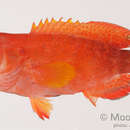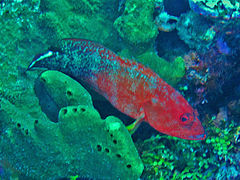Diagnostic Description
provided by Fishbase
This species is distinguished by the following characteristics: greatest body depth 2.7-3.1 in standard length; body scales ctenoid except cycloid scales ventrally on abdomen; rounded caudal fin; pelvic fins usually not reaching the anus, 1.8-2.2 in head length Colour of body reddish brown anteriorly, dark brown posteriorly; caudal fin with 2 white to bluish white bands that converge posteriorly (Ref. 90102).
- Recorder
- Estelita Emily Capuli
Life Cycle
provided by Fishbase
Protogyny is unconfirmed for this species (Ref. 103751).
Morphology
provided by Fishbase
Dorsal spines (total): 9; Dorsal soft rays (total): 14 - 16; Analspines: 3; Analsoft rays: 8 - 9
- Recorder
- Estelita Emily Capuli
Trophic Strategy
provided by Fishbase
Inhabits clear, shallow waters of outer reef areas. Also found in lagoons, back-reef areas, and on the reef-top. Feeds on small fishes (68%) and crustaceans (Ref. 5222).
Biology
provided by Fishbase
Adults inhabit clear, shallow waters of outer reef areas, in lagoons, back-reef areas, and on the reef-top. As solitary individuals (Ref. 90102), they prefer healthy coral reef in shallow areas, and are therefore greatly affected by reef degradation (Ref. 89707). They feed on small fishes (68%) and crustaceans. Because of its small size, the darkfin hind is not of much interest as a food fish (except perhaps to subsistence fisheries), but it does well in an aquarium and may find a market as an aquarium fish. They are caught with hook-and-line, gill nets, and in traps (Ref. 39231).
- Recorder
- Estelita Emily Capuli
Importance
provided by Fishbase
fisheries: subsistence fisheries; aquarium: potential
- Recorder
- Estelita Emily Capuli
分布
provided by The Fish Database of Taiwan
分布於印度-太平洋之熱帶及亞熱帶海域。西起非洲東岸,東至法屬玻里尼亞,北自日本南部,南迄澳洲大堡礁。台灣西部、東部、南部、小琉球、澎湖及蘭嶼等沿岸均有產。
利用
provided by The Fish Database of Taiwan
中小型石斑魚,不是主要經濟性魚種。一般漁法以一支釣、拖網或魚槍捕獲。台灣大多以一支釣捕獲,產量不少。食用及觀賞兼具,一般以煮湯食之,味道佳,肉質鮮美。
描述
provided by The Fish Database of Taiwan
體長橢圓形,側扁,標準體長為體高之2.7-3.3倍。頭背部斜直;眶間區平坦。眼小,短於吻長。口大;上頜稍能活動,可向前伸出,末端延伸之眼後緣之下方;上下頜前端具小犬齒,下頜內側齒尖銳,排列不規則,可向內倒狀;鋤骨和腭骨具絨毛狀齒。前鰓蓋緣圓,具微鋸齒緣平滑;下鰓蓋及間鰓蓋平滑。體被細小櫛鱗;側線鱗孔數54-68;縱列鱗數88-108。背鰭連續,有硬棘IX枚,軟條14-16;臀鰭硬棘III枚,軟條9;腹鰭腹位,末端不及肛門開口;胸鰭圓形,中央之鰭條長於上下方之鰭條,且長於腹鰭,但約略等長於後眼眶長;尾鰭圓形。體呈深紅色至紅褐色,後方較暗;頭部具許多細小橘紅色點及不規則之紅褐色斑馭;體側有時具細小淡斑及6條不顯著之不規則橫帶。背鰭及臀鰭軟條部具許多細小橘紅色點及鰭膜具橘色緣;腹鰭橘紅色且具藍色緣;尾鰭具2條淡色斜帶,斜帶間具許多淡色斑點,斜帶外為紅色而具白色緣。
棲地
provided by The Fish Database of Taiwan
棲息於水深1-60公尺左右潟湖礁石區及淺外礁斜坡處等之海域。主要以魚類及甲殼類為食。
Cephalopholis urodeta
provided by wikipedia EN

Illustration of
Cephalopholis urodeta
Cephalopholis urodeta, the darkfin hind, flagtail rockcod, chevron rockcod, duskyfin hind, duskyfin rockcod, flagtail grouper or V-tail grouper, is a species of marine ray-finned fish, a grouper from the subfamily Epinephelinae which is in the family Serranidae which also includes the anthias and sea basses. This fish occurs in the Western Pacific Ocean and the far eastern Indian Ocean.
Description
Cephalopholis urodeta has a body which is less deep than the head is long with the body being around a third as deep as the standard length. The profile between the eyes is convex and the rounded preopercle has a serrated edge and a fleshy lower edge. The maxilla extends beyond the eye.[3] The dorsal fin has 9 spines and 14-16 sodt rays while the anal fin has 3 spines and 8-9 soft rays.[2] The caudal fin is rounded and the pelvic fins do not extend to the anus.[3] Te overa;; colour of this fish is reddish-brown to pale greyish-brown, darkening towards the tail, with obvious whitish to pale blue diagonal lines across both lobes of the caudal fin. They frequently show six faint bars along the flanks, these fork towards the abdomen, and there are small orange-red spots on the head and nape, as well as a pair of dark spots near the tip of the lower lip. The pectoral fin are yellowish and there is normally a large reddish to brownish spot on the edge of the gill cover.[4] This is a small species of grouper which attains a maximum total length of 28 centimetres (11 in).[2]
Distribution
Cephalopholis urodeta is found at Christmas Island in the eastern Indian Ocean but it is mainly a species of the Western Pacific Ocean. It extends as far north as Okinawa and the Ryukyu Islands of southern Japan and as far south as the southern Great Barrier Reef of Queensland in Australia. Its range extends east as far as French Polynesia and Pitcairn Island. It has also been recorded from Phoenix Islands, Jarvis Island, Palmyra Atoll, and Kingman Reef, as well as Brunei.[1] In 1958 over 1,800 specimens of C. urodeta sourced in the South Pacific were released near Oahu in Hawaii but they failed to become established.[5]
Habitat and biology
Cephalopholis urodeta is found in clear, shallow waters in the outer areas of reefs, in lagoons, behind the reef and over the top of reefs. They are solitary and prefer healthy coral reefs in areas of shallow water where they feed on largely on small fishes, which make up 68% of its diet, and crustaceans.[2] It occurs down to depths of 60 metres (200 ft). A single male will have a territory which includes that of up to six females. The male will court the females in the afternoons.[1]
Taxonomy
This species was once regarded as widespread in the Indian Ocean, nowadays the Indian Ocean form is regarded to be Cephalopholis nigripinnis. The two species are known to hybridise at Christmas Island[4] where intermediate individuals have been recorded.[3]
Utlisation
Cephalopholis urodeta is too small to be of interest to commercial fisheries, although it is taken by subsistence fishermen.[1] It sometimes appears in the aquarium trade.[6]
References
-
^ a b c d Cabanban, A.S. (2018). "Cephalopholis urodeta". IUCN Red List of Threatened Species. 2018: e.T132783A100458618. doi:10.2305/IUCN.UK.2018-2.RLTS.T132783A100458618.en. Retrieved 19 November 2021.
-
^ a b c d Froese, Rainer; Pauly, Daniel (eds.) (2019). "Cephalolophis urodeta" in FishBase. December 2019 version.
-
^ a b c Heemstra, P.C. & J.E. Randall (1993). FAO Species Catalogue. Vol. 16. Groupers of the world (family Serranidae, subfamily Epinephelinae). An annotated and illustrated catalogue of the grouper, rockcod, hind, coral grouper and lyretail species known to date (PDF). FAO Fish. Synopsis. Vol. 125. FAO, Rome. pp. 61–62. ISBN 92-5-103125-8.
-
^ a b Bray, D.J. (2017). "Cephalopholis urodeta". Fishes of Australia. Museums Victoria. Retrieved 19 June 2020.
-
^ Fuller, P. (2020). "Cephalopholis urodeta (Forster in Bloch and Schneider, 1801)". Nonindigenous Aquatic Species Database, Gainesville, FL. U.S. Geological Survey. Retrieved 19 June 2020.
-
^ "Cephalopholis urodeta". Bob Goemans. Retrieved 19 June 2020.

- license
- cc-by-sa-3.0
- copyright
- Wikipedia authors and editors
Cephalopholis urodeta: Brief Summary
provided by wikipedia EN

Illustration of Cephalopholis urodeta
Cephalopholis urodeta, the darkfin hind, flagtail rockcod, chevron rockcod, duskyfin hind, duskyfin rockcod, flagtail grouper or V-tail grouper, is a species of marine ray-finned fish, a grouper from the subfamily Epinephelinae which is in the family Serranidae which also includes the anthias and sea basses. This fish occurs in the Western Pacific Ocean and the far eastern Indian Ocean.
- license
- cc-by-sa-3.0
- copyright
- Wikipedia authors and editors
Description
provided by World Register of Marine Species
Inhabits clear, shallow waters of outer reef areas, also found in lagoons, back-reef areas, and on the reef-top. Feeds on small fishes (68%) and crustaceans.
Froese, R. & D. Pauly (Editors). (2023). FishBase. World Wide Web electronic publication. version (02/2023).
- license
- cc-by-4.0
- copyright
- WoRMS Editorial Board



 Illustration of Cephalopholis urodeta
Illustration of Cephalopholis urodeta